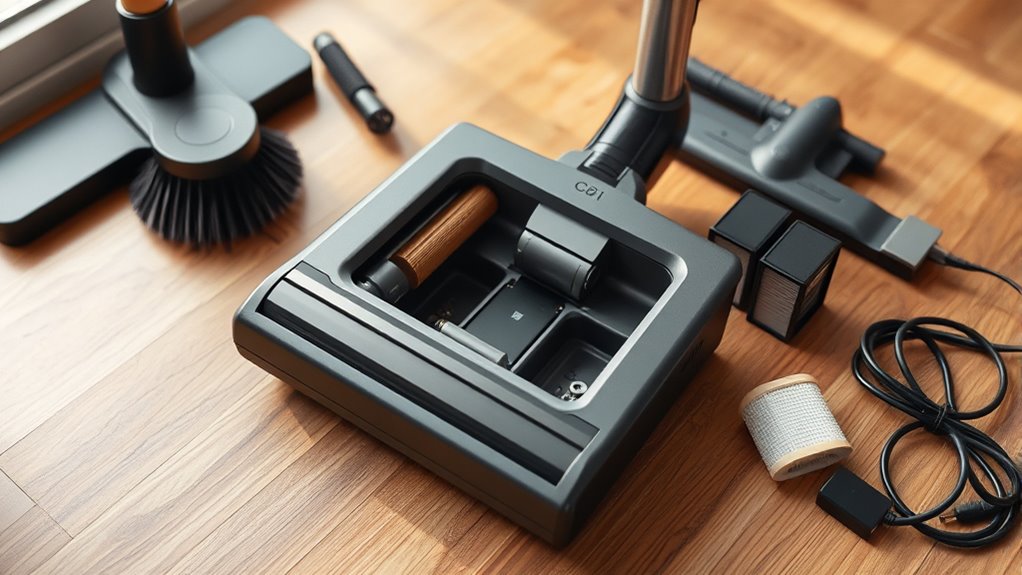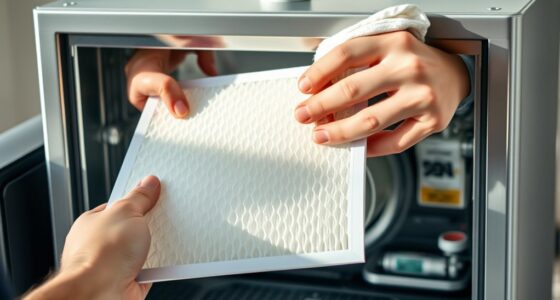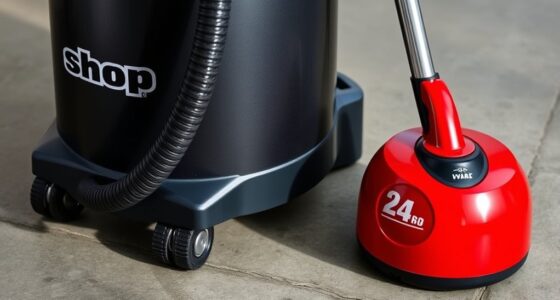To keep your vacuum batteries lasting longer and performing better, understand their types and check for signs of wear like reduced runtime or overheating. Always follow proper charging routines—avoid deep discharges and overcharging—and store batteries in a cool, dry place. Recognize early signs of deterioration so you can replace them timely. If you keep these practices in mind, you’ll extend your battery’s lifespan and maintain best cleaning power. There’s more to discover if you continue exploring.
Key Takeaways
- Regularly monitor battery health for signs of wear like reduced runtime or overheating to ensure timely replacement.
- Follow manufacturer guidelines for charging, avoiding overcharging, deep discharges, and using compatible chargers.
- Store batteries in cool, dry environments at partial charge (40-60%) to prolong lifespan and prevent damage.
- Handle batteries carefully, keep contacts clean, and dispose of old batteries responsibly through certified recycling programs.
- Use batteries suited to your vacuum’s specifications, and perform routine maintenance for optimal performance and safety.
Understanding Your Vacuum Battery Types and Specs
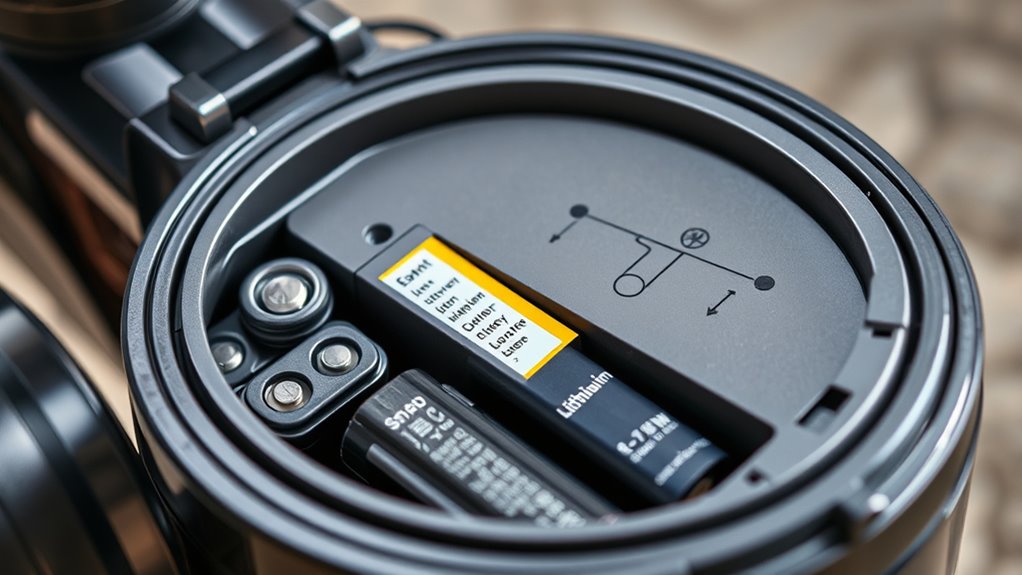
Understanding your vacuum battery types and specs is essential for maintaining ideal performance. One key aspect is battery capacity, which determines how long your vacuum can run on a single charge. Higher capacity batteries usually last longer but may be heavier. Knowing the number of charging cycles your battery can handle helps you gauge its lifespan; most batteries are rated for a specific number of cycles before performance declines. Some batteries use lithium-ion technology, offering better longevity and efficiency, while others may be older nickel-based types. By understanding these specs, you can better manage usage and avoid premature battery failure. Keep track of charging cycles and choose a battery with the right capacity for your needs to guarantee optimal performance and durability over time. Additionally, advancements in robotics integration are influencing how vacuum cleaners operate, potentially improving their efficiency through automation.
Best Practices for Charging and Discharging
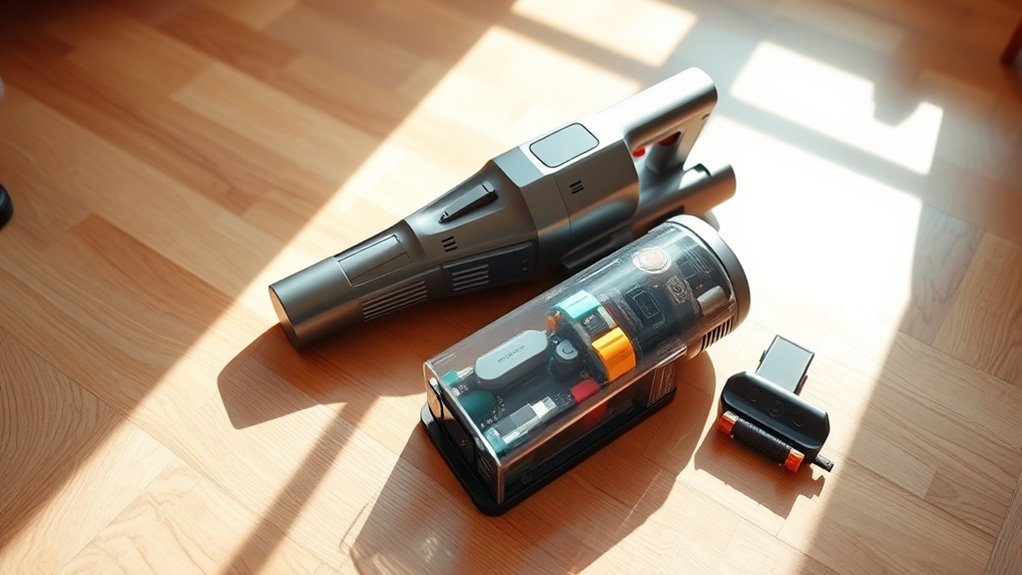
To keep your vacuum battery in top shape, it’s important to charge it at ideal times and avoid letting it over-discharge. Charging when needed and stopping before the battery runs completely out can extend its lifespan. Following these simple practices helps guarantee your vacuum performs reliably for longer. Additionally, understanding industry trends can help you stay informed about the latest advancements in battery technology and maintenance.
Optimal Charging Times
Ever wondered when the best times to charge or discharge your vacuum battery are? To maximize your battery’s lifespan, it’s best to charge it before it fully discharges and avoid letting it sit at 0%. Charging during moderate battery levels, around 20-80%, helps maintain ideal charging cycles, which directly impacts battery longevity. Don’t wait until the vacuum is almost dead to plug it in, as deep discharges can wear out the battery faster. Similarly, avoid keeping it plugged in continuously after reaching full charge, as overcharging can harm the battery over time. By timing your charges wisely, you preserve the health of your battery, ensuring consistent performance and extending its overall lifespan. Proper charging habits make your vacuum more reliable and cost-effective in the long run. Understanding battery maintenance can further help optimize your vacuum’s performance and lifespan.
Avoid Over-Discharging
Over-discharging your vacuum battery can drastically shorten its lifespan, so it’s important to prevent it from reaching zero percent whenever possible. Regularly depleting the battery completely can cause voltage fluctuations that harm the cells, leading to reduced capacity over time. To avoid this, try to recharge your vacuum before it hits critically low levels. Performing occasional battery calibration can help guarantee accurate power readings and prevent over-discharging. If your vacuum has an auto-shutdown feature, use it to protect against deep discharges. Remember, consistent partial discharges are better than full ones, preserving battery health and extending its usable life. Being mindful of voltage fluctuations during use and recharge cycles plays a vital role in maintaining your vacuum battery’s performance over the long term.
How to Store Your Vacuum Batteries Properly
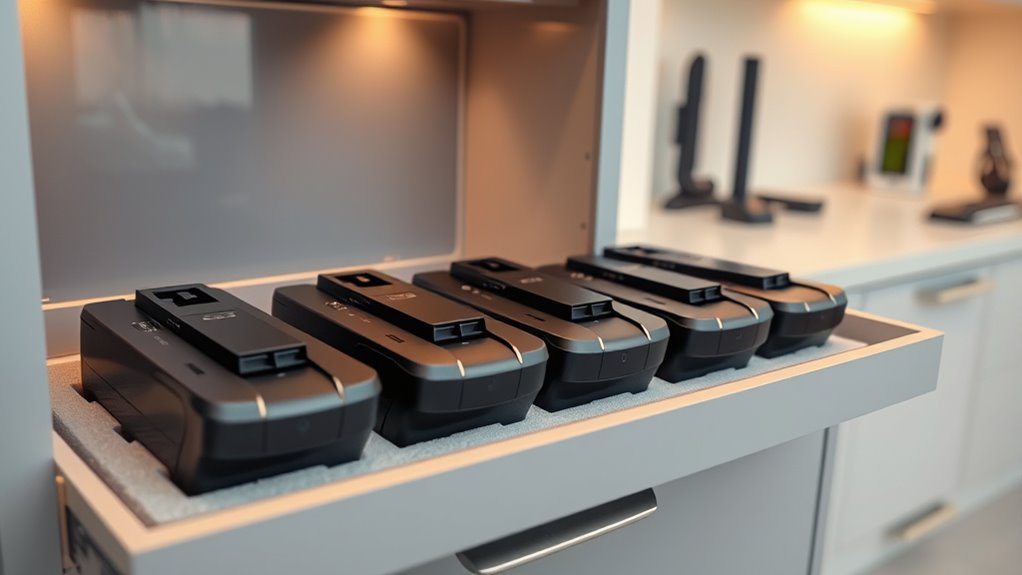
To keep your vacuum batteries in good shape, store them in a cool, dry place away from direct sunlight. You should also avoid letting them fully discharge before storage, as this can damage the cells. Make sure to keep the batteries in the proper position, typically upright, to prevent leaks or damage. Additionally, monitoring the battery health regularly can help ensure optimal performance over time.
Keep Batteries Cool and Dry
Storing your vacuum batteries in a cool, dry place helps maintain their performance and lifespan. Keep the battery temperature stable, avoiding extreme heat or cold that can damage the internal cells. Excessive heat accelerates chemical reactions, reducing battery capacity, while cold temperatures can cause internal damage. Moisture protection is equally important; moisture can lead to corrosion and short circuits. Store batteries in a location with low humidity and avoid damp areas like basements or garages. Make sure the storage space is well-ventilated to prevent moisture buildup. Additionally, keep batteries away from direct sunlight, which can raise their temperature. Proper storage conditions help guarantee your vacuum batteries stay healthy, ready, and safe for use when you need them. Maintaining optimal storage conditions also preserves the color accuracy of any integrated display or indicator lights on the battery, ensuring accurate status readings over time.
Avoid Full Discharges
If you want your vacuum batteries to last longer, it’s important to avoid letting them fully discharge before storing. Fully discharging can cause irreversible damage, reducing battery lifespan and performance. Instead, keep the batteries in a partially charged state, around 40-60%. This helps maintain excellent health and ensures better longevity. When storing batteries, consider using charging stations to keep them at the right level and prevent deep discharges. Proper disposal through battery recycling is essential when batteries are no longer usable. Avoid storing batteries in a discharged state to prevent capacity loss. Regularly check the charge level and recharge as needed. Proper storage practices extend battery life, reduce waste, and support environmentally friendly battery recycling efforts. Additionally, understanding the importance of battery maintenance can help optimize their performance and lifespan over time.
Store in Proper Position
Proper positioning of your vacuum batteries during storage helps maintain their health and performance. Store the batteries in a cool, dry place, ideally upright, to prevent leaks or damage. Avoid stacking batteries directly on top of each other, as this can cause unnecessary stress and potential short circuits. If you’re not using the vacuum for a long time, consider partially discharging the battery to around 50%, which helps prevent capacity loss. Protect the batteries from power surges by unplugging the charger and removing the batteries if possible. When it’s time to dispose of or replace your batteries, remember to follow proper battery recycling guidelines to prevent environmental harm. Correct storage ensures your vacuum batteries stay ready and safe for future use. Additionally, understanding battery safety can help prevent accidents and prolong the lifespan of your batteries.
Recognizing Signs of Battery Wear and When to Replace
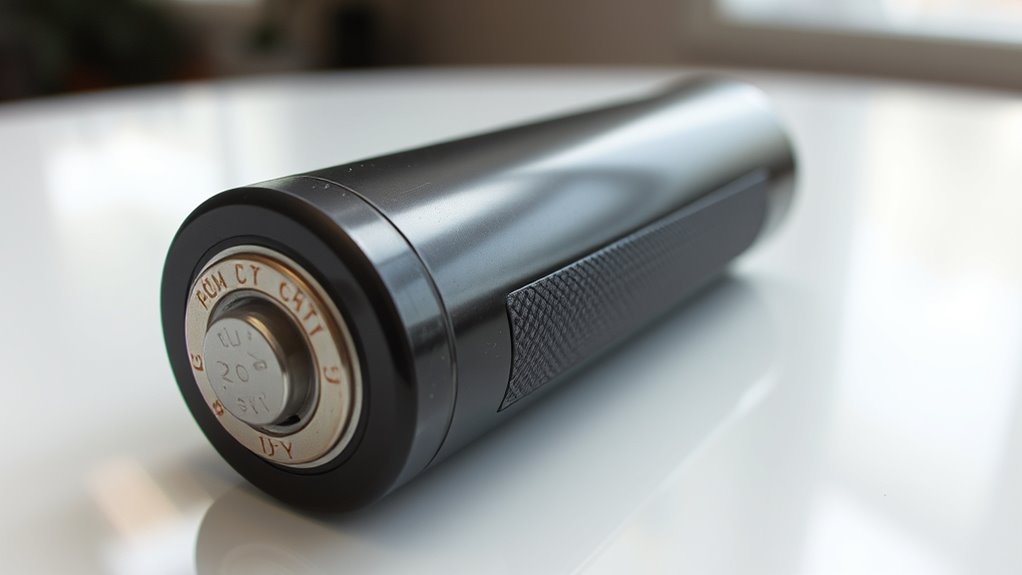
Over time, your vacuum battery will show signs of wear that indicate it’s nearing the end of its lifespan. You’ll notice a decrease in runtime, longer charging times, or inconsistent power during use. These are key replacement indicators that your battery is losing its capacity to hold a charge effectively. Keep an eye out for the following signs:
- Shorter battery life per charge
- The vacuum takes longer to recharge
- Power drops suddenly or intermittently
- The battery no longer holds a charge at all
- Using the right battery maintenance practices can help extend its overall lifespan.
These clues help you determine when it’s time to replace your battery. Ignoring these signs can lead to reduced cleaning performance and potential damage to your vacuum. Recognizing the signs of battery wear ensures you replace it before it completely fails.
Maintenance Tips to Maximize Battery Lifespan
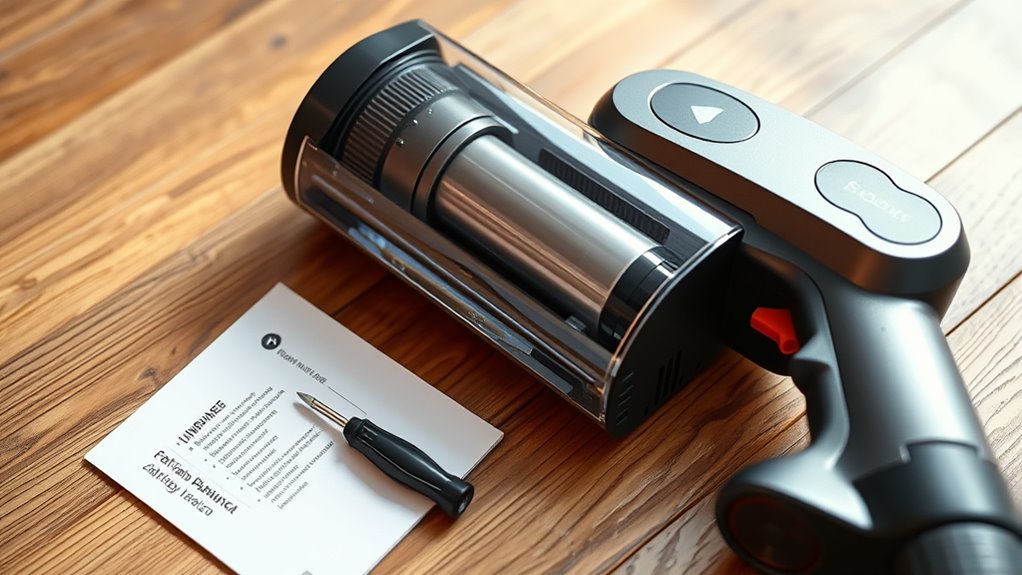
Regular maintenance can substantially extend the lifespan of your vacuum battery. Start by avoiding overcharging—disconnect the charger once the battery is full to prevent unnecessary strain. Keep your battery within recommended temperature ranges to avoid overheating or freezing, which can degrade its performance. Properly dispose of old batteries through battery recycling programs to prevent environmental harm and ensure safety. Always check for battery compatibility before replacing or upgrading to avoid damaging your vacuum. Regularly clean contacts and ensure a secure connection to maximize charging efficiency. Using the correct chargers designed for your battery type also helps prevent damage. Additionally, understanding battery chemistry can help you choose the best battery type for longevity and safety. By following these simple tips, you’ll extend your battery’s lifespan and maintain ideal vacuum performance for years to come.
Common Mistakes That Damage Vacuum Batteries
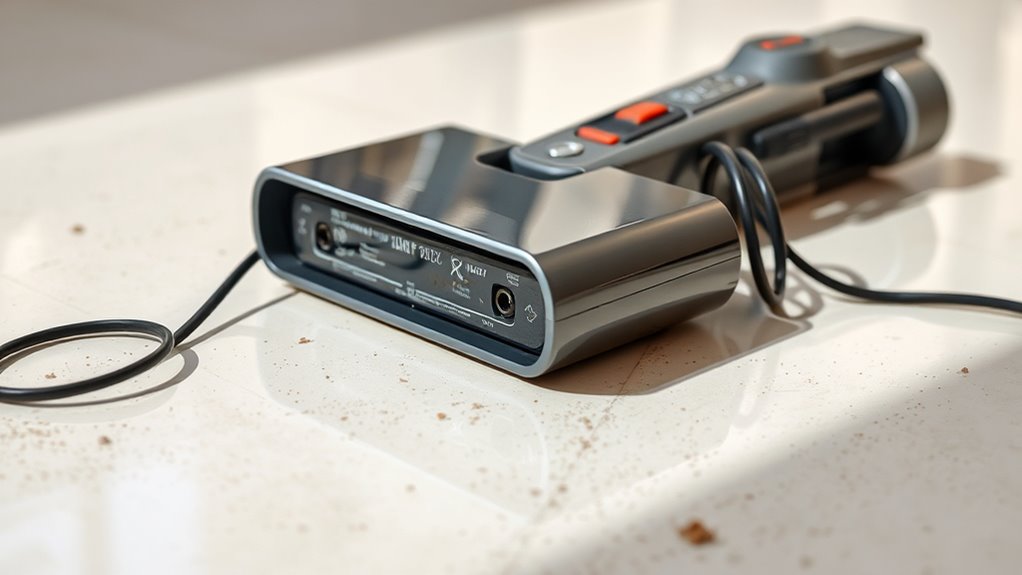
Many common mistakes can quickly damage your vacuum battery, reducing its lifespan and performance. One major error is using an incompatible charger, which can overcharge or undercharge the battery, causing long-term harm. Avoid neglecting proper battery recycling; improperly discarding batteries can lead to environmental hazards and reduce your options for safe disposal. Constantly letting your battery fully discharge before recharging can strain it and shorten its life. Additionally, ignoring manufacturer guidelines on charging cycles and storage can degrade battery health over time. To protect your investment, always ensure charger compatibility and follow recommended practices. Proper care prevents damage and prolongs battery life, saving you money and reducing waste. Being aware of newborn safety guidelines can also help you maintain a safe environment for your devices, similar to how following safe sleep practices ensures newborn well-being.
Frequently Asked Questions
How Often Should I Calibrate My Vacuum Battery for Optimal Performance?
You should calibrate your vacuum battery every 3 to 6 months to maintain peak performance. Regular battery maintenance involves following a proper calibration schedule, especially if you notice decreased runtime or inconsistent power. To keep your vacuum working efficiently, fully charge the battery, then discharge it completely before charging again. This simple routine helps prevent battery memory effects and extends its lifespan, ensuring your vacuum stays reliable.
Can Using Third-Party Chargers Harm My Vacuum Battery?
Did you know that using third-party chargers can decrease your vacuum battery’s lifespan by up to 50%? Yes, it can harm the battery if the charger isn’t designed for your model. Always prioritize charger safety by choosing chargers compatible with your vacuum’s battery. Mismatched chargers can cause overheating or damage, so stick with the original or certified alternatives to keep your battery healthy and performing at its best.
What Environmental Conditions Most Negatively Impact Battery Longevity?
You should avoid exposing your vacuum battery to extreme temperature fluctuations and high humidity levels. Cold temperatures can slow down the chemical reactions inside the battery, reducing its capacity, while excessive heat accelerates wear and shortens lifespan. High humidity promotes corrosion and internal damage. Keep your vacuum in a cool, dry place, and avoid sudden temperature changes to extend your battery’s longevity and guarantee peak performance.
Is It Safe to Leave a Vacuum Battery Charging Overnight?
Leaving your vacuum battery charging overnight isn’t recommended, as it can lead to battery overheating, which increases the risk of damage or safety hazards. Studies show that overcharging can reduce battery lifespan by up to 50%. To guarantee safe charging, always follow the manufacturer’s guidelines, avoid leaving it unattended for long periods, and use the proper charger. Prioritizing charging safety helps extend your battery’s life and prevents potential accidents.
Are There Specific Cleaning Products That Can Extend My Battery’s Life?
Using specific cleaning products designed for battery maintenance can help extend your battery’s life. Always check cleaning product compatibility with your vacuum’s battery type before applying. Focus on proper battery cleaning techniques, like gently wiping terminals with a dry cloth and avoiding harsh chemicals. Regularly inspecting and cleaning your battery ensures maximum performance and longevity, preventing corrosion or damage that could shorten its lifespan.
Conclusion
Think of your vacuum battery like a delicate plant—you need to give it the right care to thrive. When you follow proper charging, storage, and maintenance tips, it can last years instead of months. I once ignored my vacuum’s warning signs, and it died after just six months. Don’t let your battery be like that neglected plant; nurture it with knowledge, and it’ll keep your floors spotless for the long haul.
